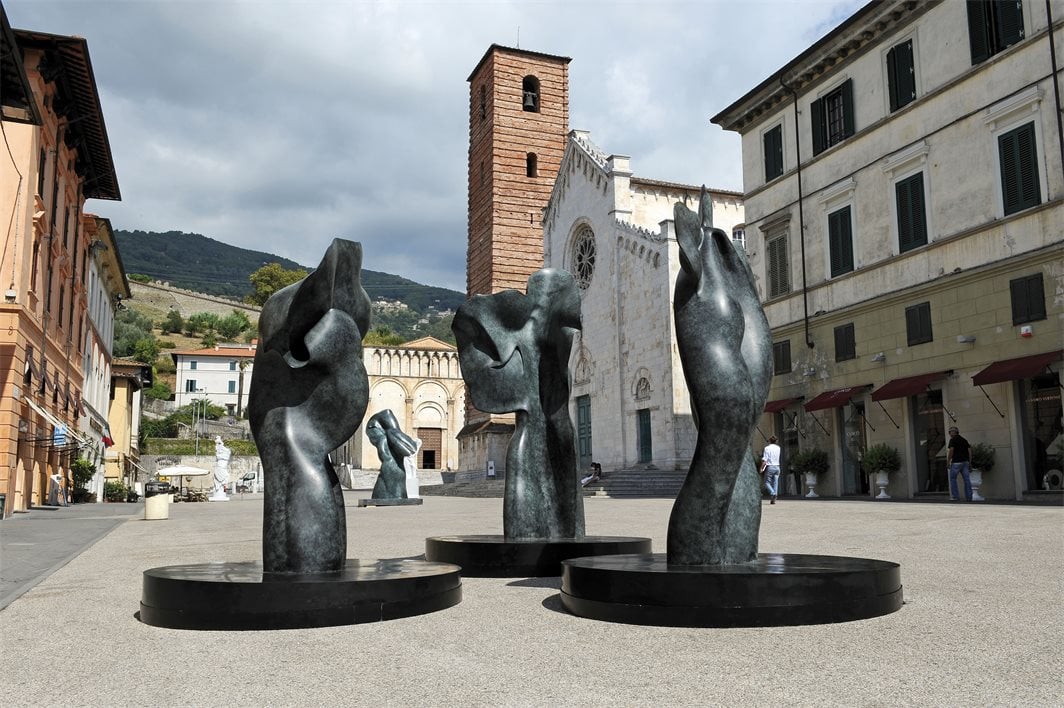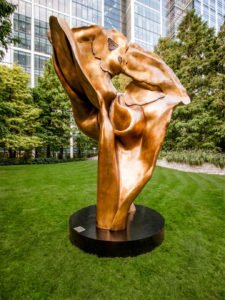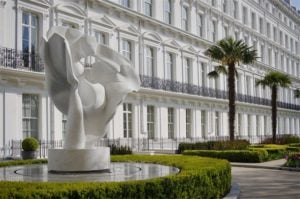Press
 The Space Within, Ascent and Cleopatra in the Piazza.
The Space Within, Ascent and Cleopatra in the Piazza. “Beauty is the Reason Public Art Exists.” Helaine Blumenfeld in an Interview
WidewallsLying in the magical zone between abstraction and figuration, Helaine Blumenfeld’s translucent marble works and flowing bronzes take the viewer’s breath away. Infusing her work with something of nature’s immutable essence rather than directly imitating it, she creates compositions that speak directly, eloquently and beautifully to our shared humanity.
An American artist living between the United Kingdom and Italy, Blumenfeld was a professor of philosophy before she turned to sculpture as a way to express her dreams and emotions. Regarded as one of the most respected sculptresses of her generation, she has been hailed as the successor to Henry Moore and Barbara Hepworth.
The work of Helaine Blumenfeld communicates on a number of levels, visual and imaginative, tactile and emotional. Stunningly beautiful, her sculptures capture and explore countless emotions of the human condition such as vulnerability, turbulence, fragility, dependency, strength, joy and beauty.
We had a chat with the artist to find out more about her work and upcoming projects. In an exclusive Widewalls interview, she talks about her upcoming solo show, the participation at the International Architecture Exhibition of the Venice Biennale later this year, working in the public space, her creative process, the necessity of taking risks, and much more.
Helaine Blumenfeld, Hard Beauty
Widewalls: The film about your life and work, “Hard Beauty”, premiered on Sky Arts this April. Could you tell us something about the collaboration with the director Rupert Edwards and the making of this film?
Helaine Blumenfeld: The experience of working on Hard Beauty with Rupert Edwards was an amazing adventure. I had been filmed by many documentary teams before where the emphasis was on quickly capturing a story. Working with Rupert and his crew was a different experience. It was apparent from the beginning that their goal was to create a film about my sculpture that would itself be a work of art!
Rupert’s hope from the first time we discussed the film was that he would be able to communicate the sense of beauty he found in my work while also unraveling the secret, private mystery of the creative process.
Although initially, I felt somewhat self-conscious, after the first session this vanished. I felt very comfortable working with Rupert, Simon and Will and was no longer aware of the camera. We had been working on the film for a few months when we decided that by following the development of a monumental sculpture from the earliest stages of the clay model to its completion in marble, and ultimately to the installation of the sculpture on site, we would be able to give viewers an insight into the many stages of the creative process. This decision meant that it took another year to complete the film.
Making this film was an inspiring collaboration, unique on many levels. We filmed in Pietrasanta where I work and in Grantchester where I have my studio. We went to Paris where my initial studies in sculpture began in the studio of Ossip Zadkine. This was a deeply emotional experience for me.
It was a great privilege for me to work with Rupert. I had been worried about how I would feel seeing the film. But watching it, I felt like a viewer rather than a participant because it was so beautifully crafted.
Widewalls: The film shows you working on a monumental marble sculpture, “Tree of Life: Encounter” for the Woolf Institute in Cambridge that was revealed this February. What is the inspiration and vision behind this piece?
HB: Tree Of Life: Encounter was inspired by the aims of the Woolf Institute in Cambridge to bring about an understanding between Jews, Christians and Muslims in order to reduce intolerance. As expressed in the words inscribed on its foundation stone “A threefold cord is not quickly broken” [Ecclesiastes 4.12].
The model for the sculpture was, as the title suggests, a tree of life. It begins with three parts of the trunk that are separate; in a sense, this represents the three religions that the Woolf Institute is trying to bring together: Judaism, Christianity and Islam. As the sculpture opens up, three strands join together and the branches reach out to suggest hope, new possibilities and spiritual regeneration.
We chose to make the sculpture in marble because it offers a real purity. The material resonates; it is timeless, hopeful and spiritual.
Widewalls: You have worked extensively in the public sphere. Why do you think it is important to bring art out of museums and galleries?
HB: For many years, I have been involved in efforts to bring sculpture out of galleries and into the streets where it can affect people in their daily lives. I have been involved with projects that were sited in hospitals, universities, community plazas, libraries, theaters and shopping centers. I have always been concerned with creating something that will provide a reference point to the people who experience it and that will connect the physical space to the conceptual space.
Beauty is the reason public art exists.

Helaine Blumenfeld – Fortuna (bronze), 2016. Canary Wharf © Henryk Hetflaisz
Upcoming Exhibitions
Widewalls: Your major solo exhibition “Tree of Life” will be on view at Ely Cathedral in Cambridgeshire later this year, bringing together 18 bronze and marble sculptures, including 7 new works. Could you tell us something about the concept of the show?
HB: The title of the exhibition, Tree of Life, takes its name from one of the most important and enduring themes in my career – despite atrocities and widespread destruction, life finds a way to renew itself.
The original concept for Tree of Life came in response to a statement made by my mother, that many Holocaust memorials have a “total absence of spirituality”. She noted that they were often depictions of objects that victims had to leave behind – empty bookcases, suitcases, vacant buildings and gravestones – which did not convey the immense loss felt then and for generations to come.
Years later, I found myself creating a sculpture that began with what looked like the trunk of a tree formed by many bodies twisted and turning, combining and informing the trunk. I realized, as I was completing it, that it represented the victims of the Holocaust.
However, instead of disappearing in smoke, the trunk moved upward and opened into a panoply of branches with a regrowth of blossoms, and clouds of many leaves, creating a sense of hope. I was trying to express that, although there had been almost unbelievable destruction, there could still be renewal and regeneration. These bodies were vanishing, but their loss might provoke society to respond with greater compassion and creativity.
This piece was the first in a series of sculptures that centered on the Tree of Life motif. Although each of my trees of life has a different emphasis, they are all about possibility and hope, healing and renewal, and represent a shift in my focus, moving from largely figurative and introspective subject matter, towards an outward-looking perspective in reaction to world events.
Widewalls: What can we expect from your work within the group show to be held during the International Architecture Exhibition of the Venice Biennale? How does it relate to other works in the show and architecture as a theme itself?
HB: I will be showing a 3.5-meter-tall bronze ASCENT at the International Architecture Exhibition of the Venice Biennale Time Space Existence.
ASCENT can be seen as my most autobiographical work. In its union of two figures, we see a theme that I have often gone back to: by balancing intimacy with independence we can create a unit of two people which has strength as well as tenderness.
In the past, I have explored this theme through tension, by forms which are stretched or even splitting apart. Here, though, the emphasis is on harmony and support. Seen from one side, the female figure soars, but her ascent would not be possible without the strength of the muscular figure that anchors her to the ground; viewed from another angle, there is an extraordinary parity between the two figures – a visual rejection of dependency in favor of inspiration, encouragement and vision.
My hope is that ASCENT will help to create a sense of space in the Marinaressa Gardens, that people will interact with the sculpture, meet there, have lunch there, that it will add to the life of the landscape.

Helaine Blumenfeld – Tempesta at The Lancasters, 2012. © Julian Jans
The Working Process of the Sculptor Helaine Blumenfeld
Widewalls: Your sculptures often deal with psychological rather than physical forms. Which stories are you trying to tell through your works?
HB: I have never felt that there was a contradiction between beauty and pain. On the contrary, only by revealing a profound emotional reality which recognizes the upheaval and disruption in our lives can we ever hope to transcend it.
Beauty is not a denial of pain, but an acceptance of it. The precondition of being an artist for me has always been a radical confrontation with reality and an effort to achieve a distance from it. For me, Hard Beauty is about what causes the viewer to struggle with reality.
These concerns have accompanied me on my journey as an artist. However, only with my more recent works have I moved from the expression of intensely personal themes to try to address the moral and physical upheaval of the wider world.
I draw inspiration from confronting the condition of the world and the chaos. I do believe that art can make a difference.
Widewalls: Despite their final light and delicate appearance, your sculptures are made of materials that are rather difficult to work with. Can you tell us something about your working process?
HB: I begin every new sculpture without any preconceived idea of what I am going to do. The key for me is to almost lose consciousness. Each time I start a new piece in clay, I tap into a part of myself with which I normally have little contact. I never use an armature to support what I am creating. This would limit me.
However, there is a danger. Sometimes the new piece will collapse in my frenzy to express it.
I go straight to clay and I can work through the night – for days even – if I’m really inspired. Eventually, a form will take shape and express what I am feeling and thinking; or, just as easily, it won’t.
I think that’s the most important aspect, that critical judgment, that standing back from what you’ve done and knowing whether or not it’s worked. It’s completely intuitive.
The work I do in clay contains the energy, the vision, the emotional landscape that will set the parameters for the completed work. I can create the initial model in a few days; to realize it in bronze or marble can take months, even years.
The craft of sculpture is in danger of being marginalized as “The Idea” and “The Concept” have become increasingly celebrated. One hears all too much about “the cutting edge.” I believe that work in any medium can be on that edge. It is not about using new materials; it is about pushing the materials and forms you are using to their limits. It is about reaching beyond the established frontiers in whatever discipline engages one.
Above all, it is about infusing the energy and originality of your own being into the work, thus transforming it and extending it into another sphere.
Art as a Commitment to Risk
Widewalls: You have been described as the Grande Dame of contemporary marble carving. Your first contact with the material was in Pietrasanta in 1975. How difficult was it to be accepted in an environment that was so male-dominated?
HB: It was very hard for me to break into the male-dominated culture of the Studios in Pietrasanta. Women were not respected. The struggle was on many levels – learning to carve, keeping discipline, overcoming the reputation of women who came before me and were not perceived to be serious.
Respect came through the sculptures I made as I learned to carve. My practice benefited from the demands made on me at the time. Today sculptors bring in models to be copied by the artisans with little understanding or involvement in the process. Working in that atmosphere forced me to discover and develop my own voice; creating works that are recognizable as mine.
This is not about innovation or even originality, but individuality. Whatever material I work with, I can only express who I am by searching within my psyche and drawing upon my inner vision and experience. These are my raw materials.
Widewalls: You were the first woman to be awarded the International Sculpture Prize Pietrasanta e la Versilia nel Mondo in 2007. What did that mean for you?
HB: I have won many prizes but none have been more important to me than the International Sculpture Prize Pietrasanta e la Versilia nel Mondo. Having come to Pietrasanta as a young artist, I learned to carve with masters around me – Moore, Botero, Pomodoro, Penalba and Cesar. There was no accolade which would mean more to me than winning this prize.
In the formal ceremony for this honor, I had the opportunity to recognize the contributions of all of the artisans whom I had worked with for so many years. Although this award had been given for 15 years, I was the first woman to receive it. This had a special meaning for me.
Widewalls: You have recently said that you are now taking more risks than ever. Why is this element of risk important in your work?
HB: Early in my career I had already understood the importance of risk and wrote:
Art is a commitment to risk as a mode of existence. It is a process or state of living right on the edge: on the edge of one’s emotional energy, on the edge of objectivity, on the edge of society, on the edge of morality, on the edge of losing what one has achieved to try something new. It is a state of consciousness in which you must always be prepared to risk everything for an enlarged sense of self-realization. It is never comfortable, but always struggling, tense, intense, painful, totally alive, eschewing the facile, I am suspicious of the ordinary, never really able to feel satisfied, always fearing the next sculpture, shaking to confront a work begun the night before. I shift between a crazy, unbridled enthusiasm and a shattering sense of self-doubt.
The belief that every aspect of creativity involves and requires risk and that risk is essential to the creative process – a condition of it has been central to my work. But even more important to me now than ever before, I feel that I must challenge my own aesthetic. To extend the boundaries of what I am creating, I must confront the forms I have already created.
As many artists have recognized, one can never escape the influence of others. Instead one has to assert oneself with the power of one’s own vision from within to express what is original. This is easier than one might imagine because as soon as you give yourself over to the process of creation, your inner subjectivity is asserted.
The challenge is not that I copy others but that I copy myself. The ability to contradict my own forms is at the basis of every break-through I make as an artist.
Helaine Blumenfeld is represented by Hignell Gallery. Her works will be on show in a solo exhibition at Ely Cathedral from 13 July until 28 October 2018.
Featured image: Helaine Blumenfeld – The Space Within, 2011. Pietrasanta © Erio Forli. All images courtesy of the artist.